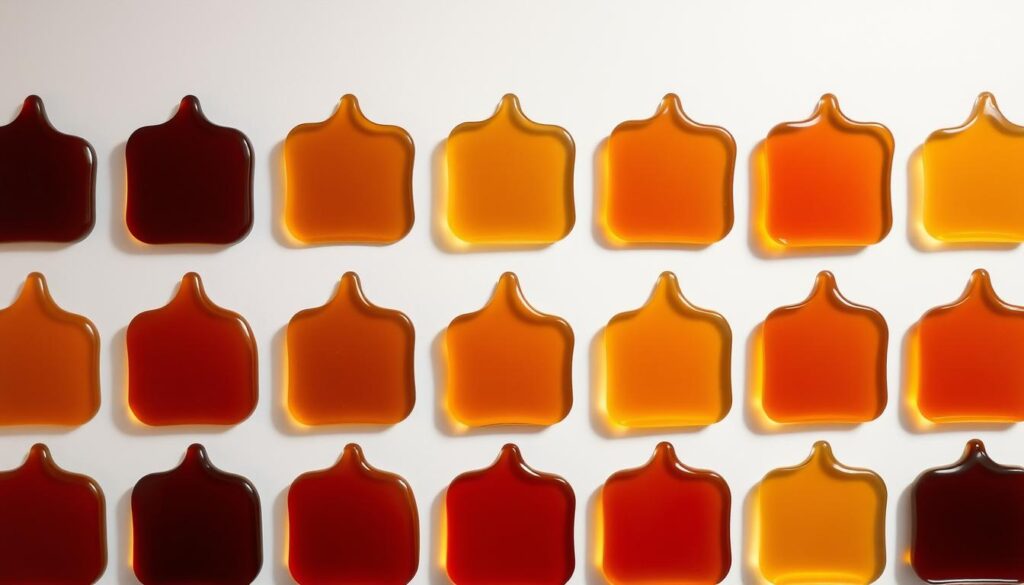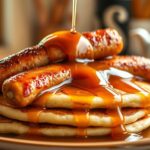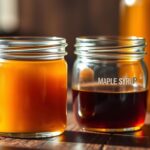Maple syrup is a natural sweetener loved by many. It has a color spectrum that is both pleasing to the eye and important for cooking. The different shades, from light golden to deep brown, show its flavor and quality. Knowing the maple syrup color chart helps anyone improve their cooking or enjoy this traditional product more.
Every color of maple syrup tells you about its maple syrup grades. These grades show its taste, smell, and quality. This syrup color guide helps you pick the right syrup for any dish. Whether it’s for sweetening pancakes or adding flavor to savory dishes, the color of maple syrup is key to understanding its uniqueness.
Next, you’ll learn how maple syrup’s color affects your cooking choices. You’ll also see how to tell different grades apart. By knowing more about maple syrup’s colors, you can make better choices and enjoy your cooking more.
Understanding the Importance of Maple Syrup Color
The color of maple syrup is key to its quality and taste. It’s not just about looks; the importance of maple syrup color affects how we taste and value it. Different colors bring different tastes, shaping our preferences based on tradition and personal taste.
The color of syrup matters in cooking too. Light syrups are great for breakfast foods like pancakes and waffles because they taste mild. Darker syrups, on the other hand, have a deeper flavor, perfect for marinades and complex recipes.
Knowing how color affects taste helps us make better choices. It improves our cooking and enjoyment of maple syrup. Whether for fancy meals or family dinners, picking the right syrup color can make a big difference.
What Is the Maple Syrup Color Chart?
The maple syrup color chart is key for both makers and buyers. It shows the wide range of syrups available. It helps people tell the different syrup colors apart, from light to dark.
Each color not only looks different but also tells us about the syrup’s taste.
Overview of the Color Spectrum
The lightest syrup is golden and tastes delicate. As the syrup gets darker, it tastes richer and more full. The darkest syrup has the strongest flavor.
Knowing this helps buyers choose the right syrup for their needs.
How to Read the Chart
Reading the chart means understanding how color relates to taste. Lighter syrups are great for drinking or baking. Darker syrups are better for marinades and glazes.
For more info, check out a syrup color guide. It helps pick the perfect syrup for your recipes.
The Maple Syrup Color Grades Explained
The color of maple syrup is key in grading it. This color shows the syrup’s quality. Knowing about maple syrup grades helps people enjoy this natural sweetener more. The USDA has four grades, each with its own color and taste.
Different Grades of Maple Syrup
The grades of maple syrup include:
- Golden: Delicate Taste – This grade has a light golden color. It’s harvested early and tastes mild. It’s great for those who like a lighter flavor.
- Amber: Rich Taste – As the season goes on, syrup turns amber. It has a stronger maple taste. This makes it perfect for cooking and baking.
- Dark: Robust Taste – This syrup is darker and has a caramel taste. It’s collected later and has a bold flavor.
- Very Dark: Intense Taste – The darkest syrup has complex flavors. It’s also full of antioxidants. Health-conscious people love it.
Quality Indicators Based on Color
The syrup’s color shows its clarity and richness. The sap’s sugar, boiling point, and harvest time affect the color. The Maillard reaction also adds to the flavors in darker syrups. For more on dark and amber syrups, click here.
Knowing about these grades helps when buying syrup. It makes choosing the right syrup easier. Whether for cooking or just enjoying, the right syrup can enhance any dish.
Types of Maple Syrup Based on Color
Exploring maple syrup color reveals different types, each with its own color. These colors show when the syrup was harvested and how it was made. Knowing about these types can make cooking more fun and help you pick the best syrup.
Maple syrup is mainly divided into three types:
- Light Syrup: Harvested early, light syrup has a light color and a mild taste. It’s great with pancakes, waffles, and yogurt because of its purity.
- Medium Syrup: Collected mid-season, medium syrup has a deeper color and taste. It’s good with roasted veggies and in marinades, adding a sweet touch.
- Dark Syrup: Harvested late, dark syrup has the strongest flavor and color. It’s perfect for baked goods, barbecue sauces, and glazes, adding depth.
These syrup types not only show their color but also guide us in choosing the right one. Knowing how to pick the right syrup can make your cooking better and more enjoyable.
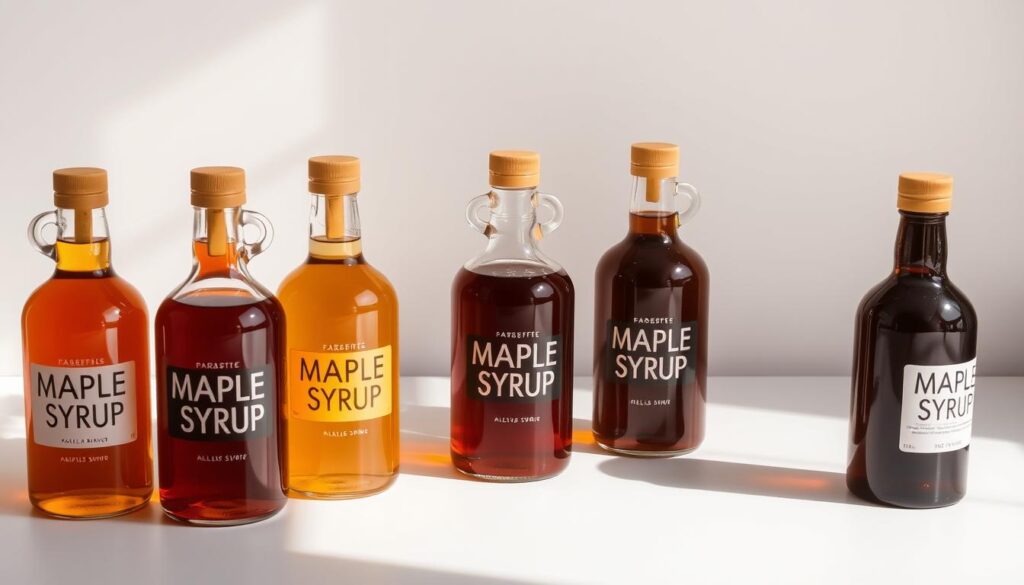
Maple Syrup Color Scale: An In-Depth Look
The maple syrup color scale is key for both looks and taste. Knowing the difference between light and dark syrup can make food better. Each color has its own taste, making dishes more exciting.
Light vs. Dark Syrup
Light maple syrup is golden and sweet. It’s great for breakfast foods like pancakes. Dark syrup, on the other hand, is richer and tastes stronger. It’s perfect for marinades and baked goods.
Flavor Associations with Color
Color affects how we choose syrup. Light syrups are smooth and sweet, with hints of vanilla and caramel. Dark syrups have bold flavors, like smokiness and toffee. This lets us pick syrups that match our taste preferences.
How Maple Syrup Color Affects Flavor
The color of maple syrup is key to its flavor. Different shades offer unique tastes, guiding our food choices. Knowing how color impacts flavor helps us pick the right syrup for our dishes.
Light Syrups: Taste Profile
Light syrups have a light taste. They often taste like vanilla and floral notes. Their sweetness is perfect for topping pancakes, yogurt, or oatmeal, letting the food’s taste stand out.
Dark Syrups: Taste Profile
Dark syrups, on the other hand, have a bold taste. They have deep flavors like caramel or toffee. These syrups are great for adding depth to baked goods, marinades, or savory dishes.
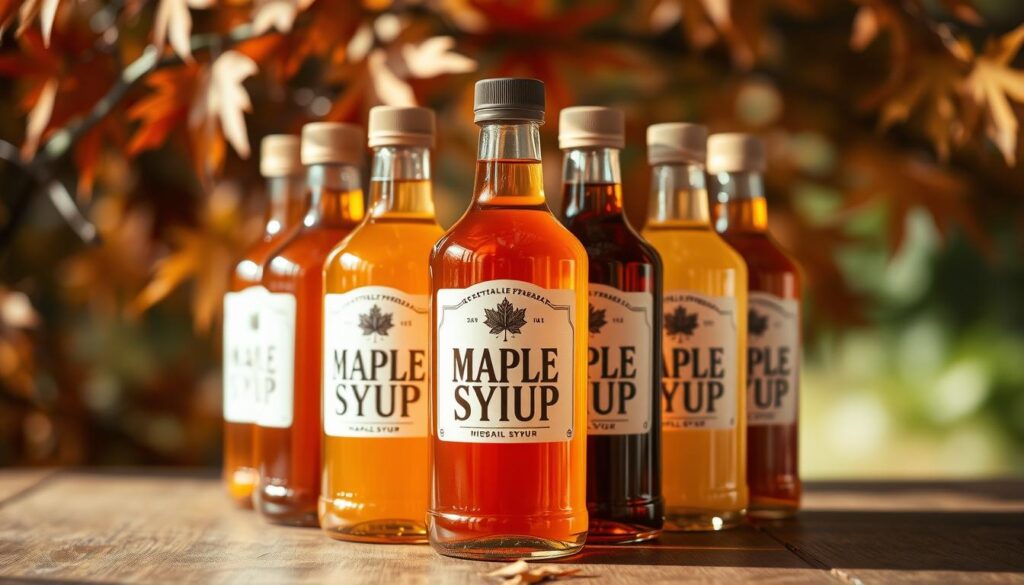
| Syrup Type | Flavor Profile | Best Uses |
|---|---|---|
| Light Syrup | Subtle, notes of vanilla and floral | Pancakes, yogurt, oatmeal |
| Dark Syrup | Rich, caramel, and toffee | Baking, marinades, savory dishes |
Understanding maple syrup’s flavor based on color helps us choose the right one. This way, we can enhance our dishes just right.
Maple Syrup Color Comparison: What to Look For
When comparing maple syrup colors, look for both visual and sensory clues. Each syrup color shows its production stage and flavor hints. Lighter syrups have a delicate taste, while darker ones are richer.
Here are key factors to consider when choosing maple syrup:
- Color Variation: Light golden syrups have a subtle taste. Deep amber syrups are richer and more complex.
- Aroma: Lighter syrups smell sweet and mild. Darker syrups have a stronger, more intense scent.
- Texture: Thicker syrup usually means a heavier flavor.
Checking syrup at the store is easy if you focus on these points. Using the maple syrup color comparison helps find the perfect syrup for your cooking.
Maple Syrup Color Standards Across the Industry
Maple syrup production follows strict rules to ensure quality and transparency. It’s important to know the maple syrup color standards. This helps make sure consumers get what they expect.
These standards cover the syrup’s color, quality, and how it’s marketed.
Regulatory Standards for Maple Syrup Color
Regulations are key in classifying and marketing maple syrup. In the U.S., groups like the Maple Syrup Producers Association set color guidelines. They define the syrup’s shades, from light to dark, and the taste each grade has.
- Light Golden: Often sought after for its mild flavor
- Medium Amber: A balanced choice for versatility in recipes
- Dark Amber: Richer flavor, popular for baking and cooking
- Very Dark: Strong flavor, typically used in recipes where sweetness unifies the dish
Importance of Consistency in Color
Syrup consistency is key for keeping consumer trust and marketing success. A consistent color lets consumers make better choices. Producers who follow the rules show they are reliable.
As the market expands, keeping color consistent helps brands stand out. It creates a unique identity in a crowded field.
Exploring the Color of Maple Syrup
To truly appreciate maple syrup, one must explore its color beyond its taste. Each shade offers a unique glimpse into the production process. It signals different qualities and flavors. Exploring syrup color can illuminate the artistry behind its creation, making it richer and more enjoyable.
The visual appeal of syrup engages the senses, adding to its charm. Whether it’s a light amber or a rich, dark brown, each color tells a story about its origins. Factors such as the time of the season and the conditions of the trees directly influence this vibrant spectrum. Understanding these elements enhances the overall enjoyment of the syrup, inviting consumers to make informed choices.
Factors Influencing the Color of Maple Syrup
The color of maple syrup comes from many factors, not just boiling. Things like the sap’s quality and how it’s made play big roles. Knowing these helps us understand why maple syrup comes in so many colors and tastes.
Environmental Factors
Things like soil health, sap sugar levels, and weather affect syrup color. Sap sugar levels change the syrup’s color, from light to dark. Sap from trees in good soil makes syrup that’s brighter.
Seasonal weather also matters. Warmer weather makes sap flow faster. This can change the syrup’s sugar level and color.
Production Methods
How syrup is made also affects its color. The boiling temperature is key. For example, boiling at 212-213°F makes golden syrup. Boiling at 216-218°F makes darker syrup.
These temperatures change the syrup’s color and taste. Small changes in temperature or boiling time can make big differences. This shows why making syrup needs to be done carefully. For more on how boiling temperatures affect syrup, check out this resource.
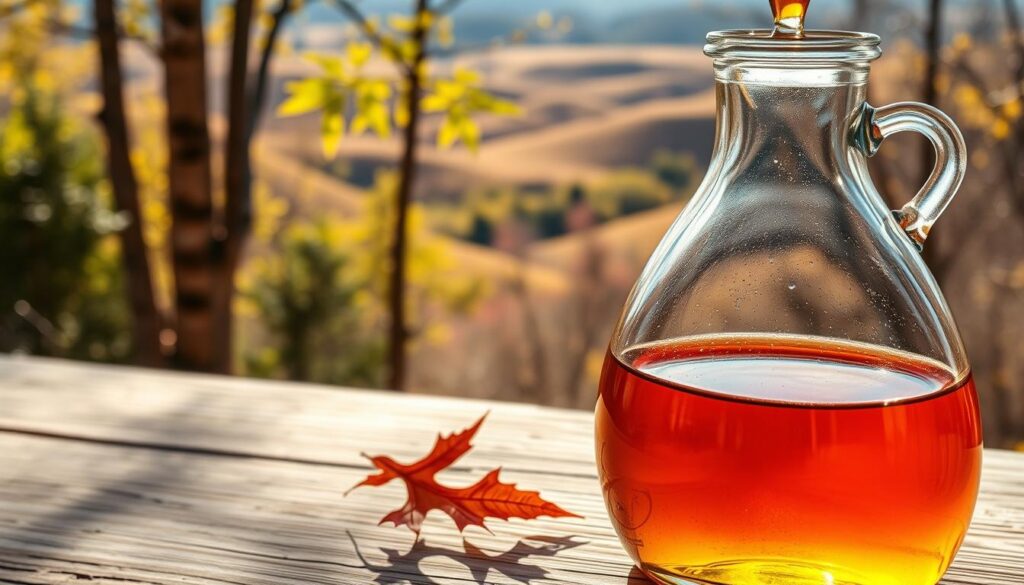
| Boiling Temperature (°F) | Syrup Color | Taste Profile |
|---|---|---|
| 212-213 | Golden | Delicate |
| 214-215 | Amber | Rich |
| 216-218 | Dark | Robust |
Using Maple Syrup Color in Cooking and Baking
The color of maple syrup is key in cooking. It affects how a dish looks and tastes. Knowing the differences in syrup types can make food taste better. This is important for both chefs and home cooks.
Choosing Syrup Based on Recipe Needs
Choosing the right maple syrup is important. Light syrups are good for pastries and dressings because they are sweet but not overpowering. Darker syrups are better for rich dishes like baked beans and glazes. They add a deep sweetness.
Chefs say to think about the syrup’s flavor when picking one. This makes a big difference in how food tastes.
Pairing Syrup Color with Foods
Maple syrup can make food taste even better. Light syrup goes well with fruits and vanilla desserts. Dark syrup is great with chocolate and meats because it adds depth.
Knowing how to pair syrup colors with food makes meals better. It also lets cooks get creative in the kitchen.
Maple Syrup Color Classification Systems
Maple syrup color classification systems give us a peek into the world of this natural sweetener. These systems range from local traditions to global standards. Knowing about these systems helps producers and buyers understand the syrup’s value.
In North America, the USDA sets four main grades of maple syrup. These are Golden, Amber, Dark, and Very Dark. Each grade shows how syrup making and harvesting have changed over time.
Worldwide, maple syrup’s color and taste are linked in a clear way. This makes it easier for buyers to pick what they like. Sugarmakers work hard to make syrup that fits into these categories, showing off the syrup’s natural differences.
The table below shows the main features of maple syrup color classification:
| Grade | Color Description | Taste Profile |
|---|---|---|
| Golden Color | Light | Delicate, subtle maple flavor |
| Amber Color | Medium | Rich, pronounced maple flavor |
| Dark Color | Dark | Strong, robust flavor |
| Very Dark Color | Very Dark | Extremely intense maple flavor |
For more on maple syrup’s flavors, check out maple syrup color classification. This knowledge makes buying syrup more fun and shows the skill of sugarmaking.
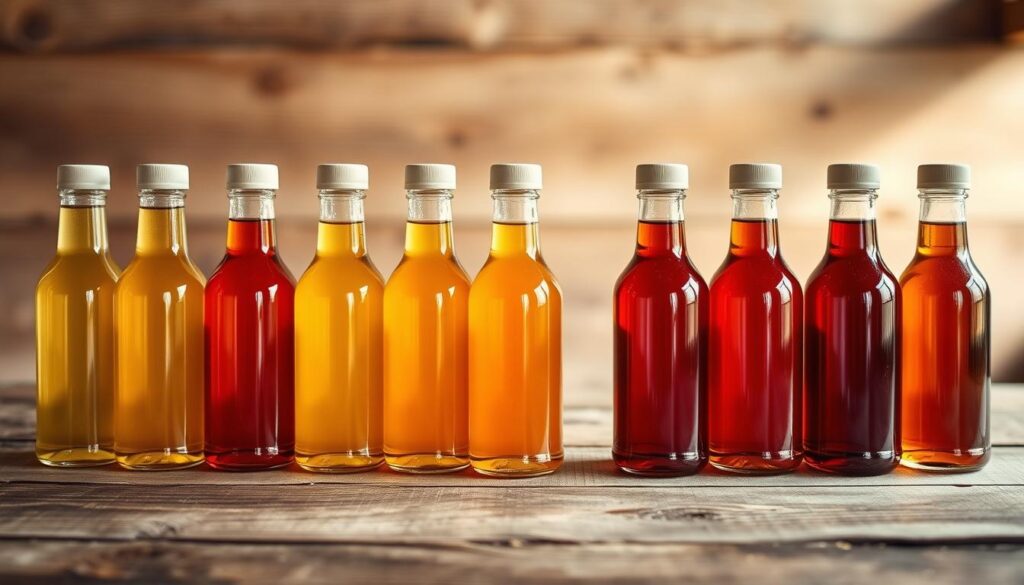
Tips for Identifying Maple Syrup Color at Home
Learning to identify maple syrup color at home can make your cooking better. Knowing how to check syrup color helps you pick the right one. This way, you can choose syrup that tastes good and is of high quality.
Visual Inspection Techniques
Here are some tips to help you see the syrup’s color better:
- Natural Light Examination: Place the syrup near a natural light. This makes it easier to see the color.
- Glassware Selection: Use clear glass or white ceramic. This makes the syrup’s color stand out more.
- Consistency Observations: Swirl the syrup gently. This helps you see if it’s smooth and even.
- Comparative Analysis: Compare it to a color chart if you have one. This helps you tell golden, amber, or dark syrup apart.
Getting good at identifying maple syrup color at home can make your cooking better. It lets you pick the best syrup for your dishes. For more tips, check out maplesyrup talk.
Regional Variations in Maple Syrup Color
Different parts of North America make maple syrup in various colors. This is because of different weather and land conditions. Each area’s special features make its syrup stand out, adding to the variety of local products.
By learning about these differences, we can better enjoy our syrup. We can appreciate where it comes from and how the environment affects its taste and quality.
North American Differences
The maples in North America create a wide range of syrup colors. This is due to many factors, like the soil and weather. Here are some key places:
- Vermont: Known for its lighter, amber syrups, Vermont’s cool climate and specific soil types contribute to the subtle flavors found in its products.
- New York: Producing a wide range of syrup colors, New York’s diverse geographical features lead to variations in sweetness and richness.
- Canada: Quebec, in particular, is famous for darker syrups, which offer robust flavors ideal for culinary uses.
Knowing these differences helps us value the variety of syrup colors from North America. Each syrup bottle tells a story about the land it comes from.
Storing Maple Syrup: How Color Affects Shelf Life
Storing maple syrup right is key to keeping it fresh and tasty. The syrup color shelf life plays a big role in how long it stays good. Darker syrups last longer, while lighter ones need more care. Knowing this helps you store maple syrup better.
Here are some tips for storing maple syrup:
- Store it in a cool, dark spot to avoid light and heat damage.
- Use an airtight container to keep it from getting moist and spoiling.
- Chill lighter syrups in the fridge to make them last longer after opening.
The table below shows how syrup color affects its shelf life:
| Syrup Color | Shelf Life (Unopened) | Shelf Life (Opened) |
|---|---|---|
| Light Amber | 1 year | 6 months |
| Medium Amber | 2 years | 8 months |
| Dark Amber | 3 years | 1 year |
Knowing these tips helps keep maple syrup tasty and safe. Good storage is essential for enjoying this natural treat for a long time.
Conclusion
Exploring maple syrup color shows its deep importance in quality and taste. We’ve looked at how different shades affect its look and taste. Terms like “Golden” and “Dark” help us understand these differences.
Using tools like UV/VIS spectrophotometers makes measuring syrup color more accurate. This shows how color is key in ensuring syrup quality. For more on maple syrup color, check out this detailed analysis from American Laboratory.
Understanding maple syrup’s color can make it even more enjoyable. It lets us appreciate the effort that goes into making it. This knowledge helps us choose the best syrup for our cooking and meals.

